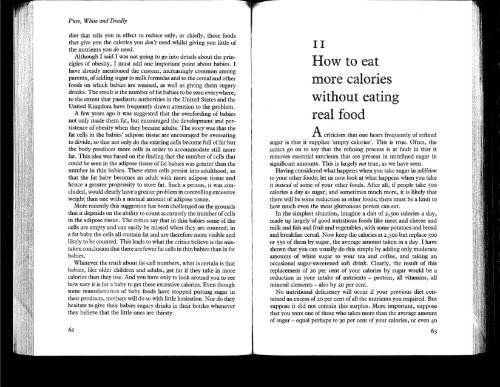John_Yudkin_-_Pure_White_and_Deadly_revised_1986_OCR
John_Yudkin_-_Pure_White_and_Deadly_revised_1986_OCR
John_Yudkin_-_Pure_White_and_Deadly_revised_1986_OCR
You also want an ePaper? Increase the reach of your titles
YUMPU automatically turns print PDFs into web optimized ePapers that Google loves.
<strong>Pure</strong>, <strong>White</strong> <strong>and</strong> DeadbJ<br />
diet that tells you in effect to reduce only, or chiefly, those foods<br />
that give you the calories you don't need whilst giving you little of<br />
the nutrients you do need.<br />
Although I said I was not going to go into details about the principles<br />
of obesity, I must add one important point about babies. I<br />
have already mentioned the custom, increasingly common among<br />
parents, of adding sugar to milk formulas <strong>and</strong> to the cereal <strong>and</strong> other<br />
foods on which babies are weaned, as well as giving them sugary<br />
drinks. The result is the number of fat babies to be seen everywhere,<br />
to the extent that paediatric authorities in the United States <strong>and</strong> the<br />
United Kingdom have frequently drawn attention to the problem.<br />
A few years ago it was suggested that the overfeeding of babies<br />
not only made them fat, but encouraged the development <strong>and</strong> persistence<br />
of obesity when they became adults. The story was that the<br />
fat cells in the babies' adipose tissue are encouraged by overeating<br />
to divide, so that not only do the existing cells become full of fat but<br />
the body produces more cells in order to accommodate still more<br />
fat. This idea was based on the finding that the number of cells that<br />
could be seen in the adipose tissue of fat babies was greater than the<br />
number in thin babies. These extra cells persist into adulthood, so<br />
that the fat baby becomes an adult with more adipose tissue <strong>and</strong><br />
hence a greater propensity to store fat. Such a person, it was concluded,<br />
would clearly have a greater problem in controlling excessive<br />
weight than one with a normal amount of adipose tissue.<br />
More recently this suggestion has been challenged on the grounds<br />
that it depends on the ability to count accurately the number of cells<br />
in the adipose tissue. The critics say that in thin babies some of the<br />
cells are empty <strong>and</strong> can easily be missed when they are counted; in<br />
a fat baby the cells all contain fat <strong>and</strong> are therefore more visible <strong>and</strong><br />
likely to be counted. This leads to what the critics believe is the mistaken<br />
conclusion that there are fewer fat cells in thin babies than in fat<br />
babies.<br />
Whatever the truth about fat-cell numbers, what is certain is that<br />
babies, like older children <strong>and</strong> adults, get fat if they take in more<br />
calories than they use. And you have only to look around you to see<br />
how easy it is for a baby to get these excessive calories. Even though<br />
some manufacturers of baby foods have stopped putting sugar in<br />
their products, mothers will do so with little hesitation. Nor do they<br />
hesitate to give their babies sugary drinks in their bottles whenever<br />
they believe that the little ones are thirsty.<br />
II<br />
How to eat<br />
more calories<br />
without eating<br />
real food<br />
A criticism that one hears frequently of refined<br />
sugar is that it supplies 'empty calories'. This is true. Often, the<br />
critics go on to say that the refining process is at fault in that it<br />
removes essential nutrients that are present in unrefined sugar in<br />
significant amounts. This is largely not true, as we have seen.<br />
Having considered what happens when you take sugar in addition<br />
to your other foods; let us now look at what happens when you take<br />
it instead of some of your other foods. After all, if people take 500<br />
calories a day as sugar, <strong>and</strong> sometimes much more, it is likely that<br />
there will be some reduction in other foods; there must be a limit to<br />
how much even the most gluttonous person can eat.<br />
In the simplest situation, imagine a diet of 2,500 calories a day,<br />
made up largely of good nutritious foods like meat <strong>and</strong> cheese <strong>and</strong><br />
milk <strong>and</strong> fish <strong>and</strong> fruit <strong>and</strong> vegetables, with some potatoes <strong>and</strong> bread<br />
<strong>and</strong> breakfast cereal. Now keep the calories at 2,500 but replace 500<br />
or 550 of them by sugar, the average amount taken in a day. I have<br />
shown that you can usually do this simply by adding only moderate<br />
amounts of white sugar to your tea <strong>and</strong> coffee, <strong>and</strong> taking an<br />
occasional sugar-sweetened soft drink. Clearly, the result of this<br />
replacement of 20 per cent of your calories by sugar would be a<br />
reduction in your intake of nutrients - protein, all vitamins, all<br />
mineral elements - also by 20 per cent.<br />
No nutritional deficiency will occur if your previous diet contained<br />
an excess of 20 per cent of all the nutrients you required. But<br />
suppose it did not contain this surplus. More important, suppose<br />
that you were one of those who takes more than the average amount<br />
of sugar - equal perhaps to 30 per cent of your calories, or even 40<br />
63



